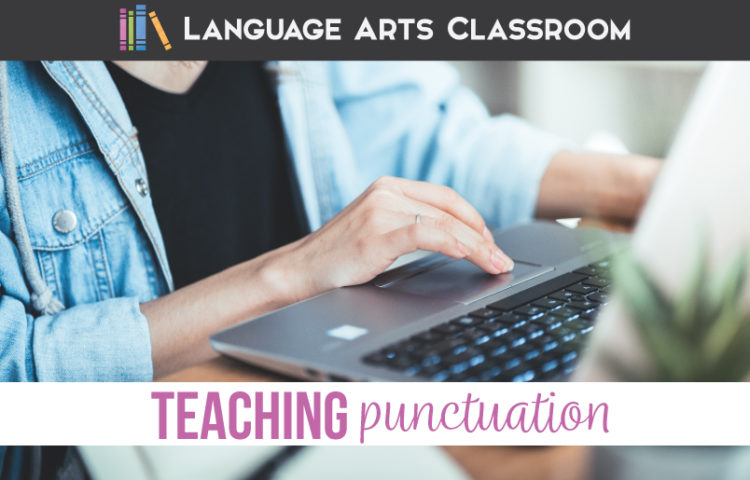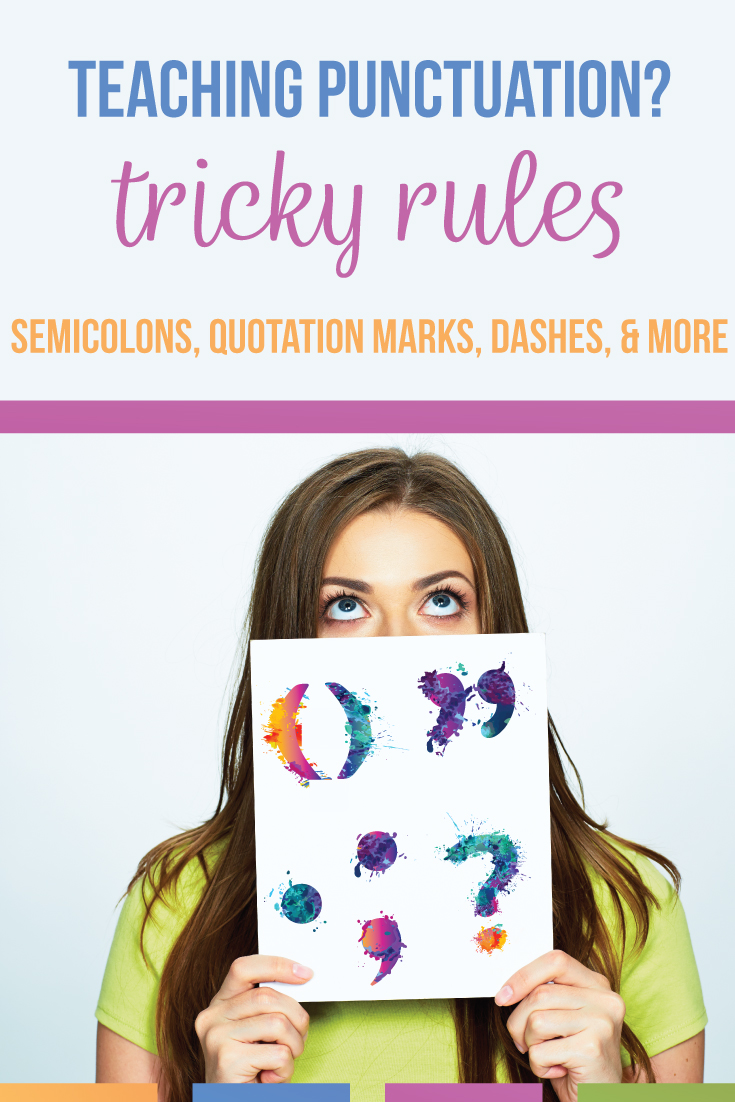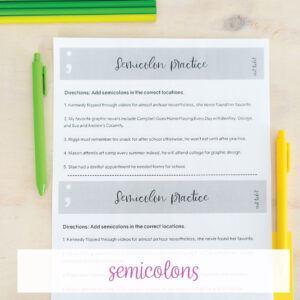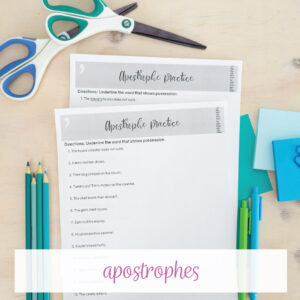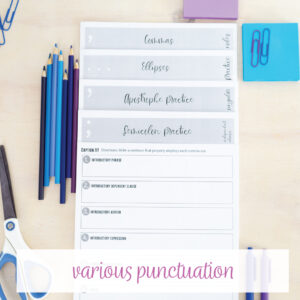Teaching punctuation rules? I have a punctuation guide for teachers and students!
Teaching punctuation cannot happen in a “unit.” When we present punctuation resources and never tie those ideas to writing, we’re not setting students up for application. Instead, present the rules of punctuation with other grammar lessons and alongside writing. When you do provide direct instruction in punctuation lessons, immediately write a few sentences with students.
Incorporating punctuation lessons into student writing is one pillar of teaching punctuation. The other pillar is that students must realize rules concerning language evolve and change. In fact, standards for older students require such lessons. When I teach punctuation rules, I show students how to consult resources to ensure they have the most updated rules and to show students how to follow them. Lessons on punctuation should be more than simple memorization.
For instance, when I review the period and question mark, students and I discuss the evolution of language. I lump teaching the period and question mark (and often the exclamation mark) together because I don’t provide direct instruction with these marks for older students.
Concerning these marks, students and I discuss how authors take liberties with them, and how students can play around with them. Look:
Take for instance? No? I don’t want to go there!
That is a casual part of a conversation, and the “rules” might be that a comma or a period be used. Instead, a question mark provides emphasis for the speaker’s tone. When you have discussions about playing with punctuation (or any grammar rule), you are engaging students and connecting grammar to their lives.
Throughout my punctuation guide for teachers, I’ve included examples and talking points. All of the teaching ideas that I mention in this post about teaching punctuation are in my punctuation bundle, and most of the activities are editable.
Below, I’ve included a basic punctuation guide for teachers and students. If you need talking points for grammar, these punctuation ideas should give you a starting point!
Commas
Lessons on punctuation almost always include commas, but I’m not going to write much about commas in this blog post! Commas are so intense and diverse that I wrote an entire blog post simply for commas. Check out my advice for teaching commas and download my free student handout.
My favorite comma activity includes pictures. I created a goofy set of pictures and run students through all of the common comma rules; I call the activity Caption It. For each picture, students must write a sentence that employs a rule. For instance, I have a picture of a dog typing. Students must create a sentence that uses a comma of direct address.
I present the rule, and then students and I directly apply that rule to writing. I follow that format for all punctuation lessons.
Teaching Semicolons
Teaching semicolons is a great addition to punctuation lessons because a semicolon has so many uses. A semicolon is the “winky face” in texting. Overall, semicolons work with conjunctive adverbs, short independent clauses, and long lists.
Walk students through the rules, and then write with them. Here are sample talking points and examples.
Review conjunctive adverbs with students, and then show students how to add the semicolon and comma:
Tyson wanted to read his book; however, he took his dog on a walk. (with a conjunctive adverb)
Use a semicolon to join two independent clauses that are related in thought:
Tomi has homework; she’ll work after dinner. (with two short independent clauses)
Finally, use a semicolon to separate long lists, especially long lists that contain other punctuation.
Mom traveled to Denver, Colorado; St. Louis, Missouri; and Peoria, Illinois. (with cities and state)
I am currently reading George, the king, and I; Ella, My Sister: A Story; and Denise, a Hero. (book or movie titles)
When you’re providing direct instruction for punctuation rules, take these examples with you as a guide! Soon, you’ll be asking students to provide examples and won’t need my talking points. Teaching semicolons requires lots of application to writing.
Teaching Apostrophes
Punctuation lessons typically include apostrophes because students find them confusing. An apostrophe serves two main purposes: to show possession, and to create a contraction.
With older students, I build on prior knowledge whenever I can. Doing so boosts students’ confidence with grammar and writing. Students probably have covered apostrophe rules but need a quick review.
Brainstorm the contractions they use in writing: don’t, can’t, shouldn’t, we’ll. Then discuss formal use in writing. Explain that in formal writing, people typically don’t use contractions. In casual writing, like an email to a peer, contractions are acceptable.
Next, review apostrophes with possession. Again, students might need a quick discussion. I also encourage students to use the online dictionary for support. In a few years, our older students will be in the workplace or college. They’ll need to figure out possession and spelling on their own.
Teaching other punctuation
So, the main punctuation lessons I teach cover commas, semicolons, and apostrophes. Older students normally arrive understanding the period, exclamation mark, and question mark.
That isn’t to say I don’t talk about those important tools! However, I rarely need to provide direct instruction over them. Teaching punctuation marks that are infrequently used, however, takes additional direct instruction and practice.
I do have other lessons on punctuation marks that take less time simply because students don’t use those marks as much. Below, I’ve included ideas for how to teach punctuation students might not use frequently.
Teaching Colons
Often, I teach colons with research papers because students use them to introduce research. Start with that fact, and explain that colons have other uses too.
For instance, a colon can introduce a list or an explanatory independent clause. Look:
I have several errands: the coffee shop, grocery store, and post office. (list)
Jamie had a thought: he would mow the lawn tonight. (explanatory independent clause)
I don’t find myself using colons often, but that doesn’t mean that your students won’t find them useful! Present this punctuation mark as a tool for spicing up their writing.
Teaching Parentheses
I almost think of the parentheses as an aside. Parentheses can be plucked from a sentence, and the sentence will still make sense.
Grandma always brings her best meal (biscuits and gravy) to our brunches.
Write a few goofy sentences with students so that they get the feel of parentheses. Remind them that they will also use parentheses with research.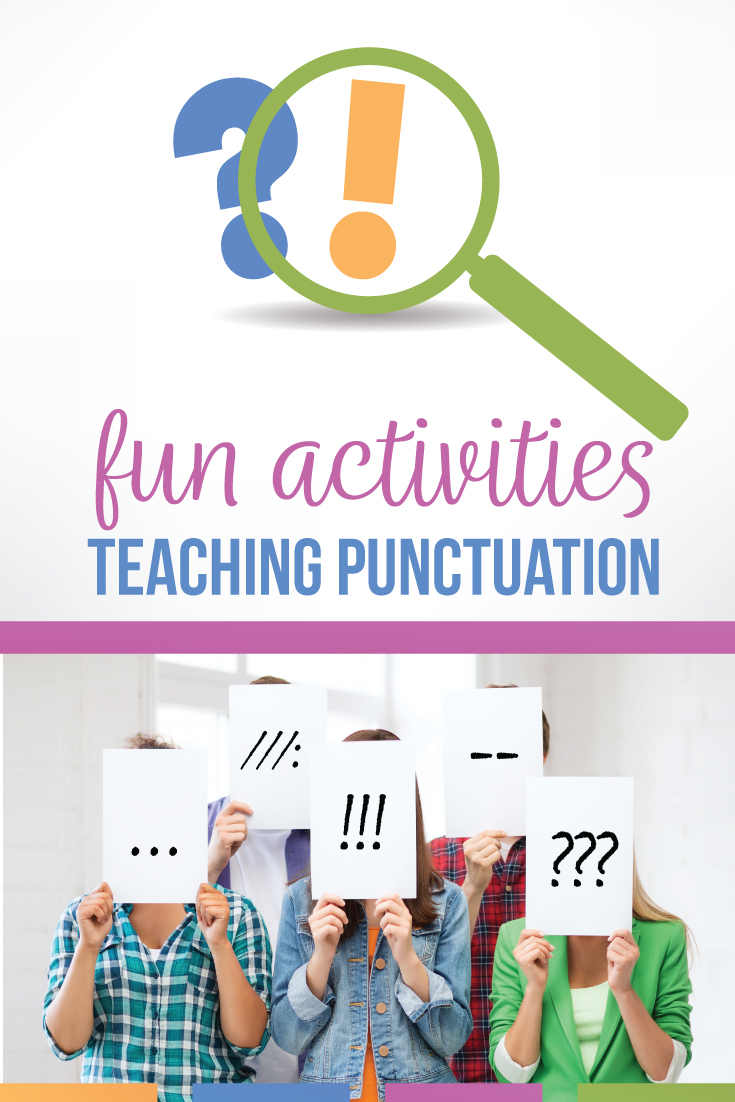
Teaching Hyphens
Thy hyphen puts words together. If student writers have two words that cannot be used separately, they need a hyphen.
My ex-girlfriend dislikes movie theaters.
Again, students can always consult an online resource to double check changing rules on hyphens. If you’d like to connect a modern discussion to your hyphen lesson plan, show students how the AP recently changed their rules on hyphen use. Explain to students that grammar and punctuation rules are not static; language changes and grows.
Teaching Dashes
The dash provides emphasis; it is fun and versatile. Writers use the dash to set off words or clauses for emphasis. The dash is less formal than the semicolon.
I don’t have time for that—that pile of laundry.
When I teach creative writing, students and I discuss using dashes for authentic dialogue. With advanced students, we might dive into the M dash and the N dash.
Teaching Quotation Marks
For me, teaching quotation marks are the most difficult tool because of the very specific rules.
Largely, students need a reminder that periods go on the inside of quotation marks:
Gina replied, “I made this pamphlet to highlight our organization.”
When I teach quotation marks, I often pull up a frequently updated website (like Owl Purdue or the dictionary) and show students how to utilize the explanations. We also discuss that different countries have different rules. As I’ve mentioned before, my students will soon be using these tools without my help. They need resources to consult. Model reading the directions and applying the tools.
Teaching Ellipses
I completely grammar-nerd with my students and start our discussion of the ellipsis with a review of plural and singular use for the actual word.
Then, we talk about the fun that an ellipsis can be in writing, specifically in dialogue. Show students the power of the three little dots to build suspense:
My parents stared at me, and I knew they were disappointed. “I just don’t know. . .” mom began.
Students won’t use the ellipsis often, but their knowledge of it is another tool in their writing toolkit, which is how I present all punctuation lessons for students: a powerful tool.
Teaching punctuation is a year-round task. The rules are numerous and difficult. Remind student of how to use them, present a variety of activities, and ask students to find the rules for their writing.
I hope this brief punctuation guide for teachers and students benefits you! Punctuation lessons can be taught all year with clarification along the way. If you need targeted activities, my punctuation bundle covers these ideas and more.


